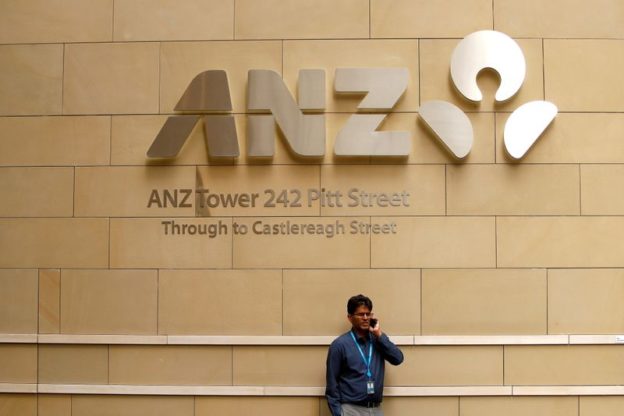© Reuters. FILE PHOTO: A man talks on his phone in front of an ANZ Banking corporation tower in central Sydney, Australia February 20, 2018. REUTERS/Daniel Munoz
By Paulina Duran
SYDNEY (Reuters) – Australia and New Zealand Banking Group’s annual profit jumped 65% as it released funds kept aside to cover potential bad loans, but it acknowledged it had not done enough to capitalise on a pandemic-induced boom in home lending.
The bank’s home loan volumes in Australia fell 1% in the second half to A$278 billion, despite a 20% surge in nationwide home prices driven by an unprecedented amount of fiscal spending.
“We started the year really well in home loans and then, of course, we saw just unbelievable levels of volume across the economy in terms of turnover, people buying and selling houses. Now we didn’t prepare well and that’s on me,” Chief Executive Shayne Elliott said in a published internal interview.
Since 2019, Australian home loan market share for the country’s No. 4 lender has fallen 70 basis points to 13.9% in August, to the benefit of its larger rivals.
By comparison, Commonwealth Bank, the country’s largest lender, grew its home lending market share over its financial year to end-June by 30 basis points to 25.3%.
Elliott said having ANZ’s home loan book grow in line with its larger peers by the end of the current business year would be a top priority.
ANZ has hired staff to address problems with loan processing times and has a team of hundreds of engineers building a “cornerstone” online banking and lending service called ANZ Plus aimed at accelerating growth.
Currently, about 56% of its home loans are sold through brokers who are not getting sufficiently quick assessment responses from ANZ, the bank said, adding that ANZ Plus, which will be launched next year, will help resolve its problem boosting volumes.
Like many other banks globally, ANZ has benefited from releasing cash set aside for potential bad loans resulting from the pandemic. Cash profit from continuing operations came in at A$6.2 billion ($4.7 billion) for the year ended Sept. 30, 4% ahead of expectations.
The bank declared a second-half dividend of A$0.70 per share dividend, 2 cents higher than the previous half.
ANZ shares were 0.5% higher in afternoon trade compared to a slightly lower broader market.
In New Zealand, a market the lender dominates, home loans grew 11% during the year and net interest margin, a key measure of profitability, grew 2 basis points to 2.34%.
Group net interest margin was one basis point higher at 1.64%, mainly due to ultra-cheap funding costs.
Elliott said ANZ remained committed to having a cost base of A$8 billion in two years time but flagged expenses in the current business year would top the A$8.7 billion it just reported as it is investing in its new service.
($1 = 1.3303 Australian dollars)
Disclaimer: Fusion Media would like to remind you that the data contained in this website is not necessarily real-time nor accurate. All CFDs (stocks, indexes, futures) and Forex prices are not provided by exchanges but rather by market makers, and so prices may not be accurate and may differ from the actual market price, meaning prices are indicative and not appropriate for trading purposes. Therefore Fusion Media doesn`t bear any responsibility for any trading losses you might incur as a result of using this data.
Fusion Media or anyone involved with Fusion Media will not accept any liability for loss or damage as a result of reliance on the information including data, quotes, charts and buy/sell signals contained within this website. Please be fully informed regarding the risks and costs associated with trading the financial markets, it is one of the riskiest investment forms possible.

Comments are closed